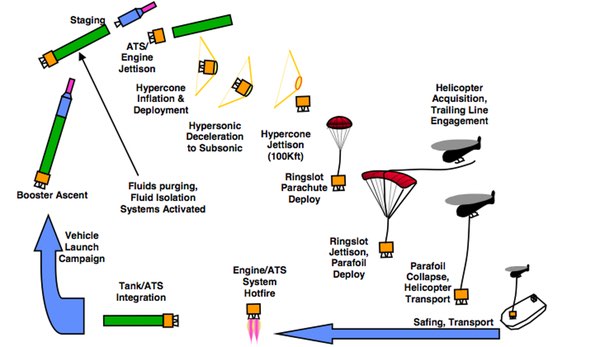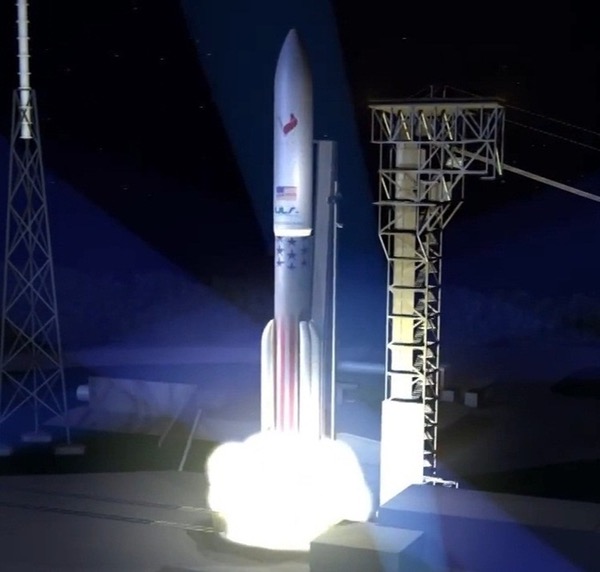Flash foresight, hard trends, and commercial space businessby Anthony Young
|
| Musk has clearly demonstrated flash foresight across a number of industries. |
None of this comes as a surprise to Daniel Burrus, a technical forecaster and strategic business advisor to Fortune 500 companies. He is the author of Technotrends (1994) and his 2011 book, Flash Foresight – How to See the Invisible and Do the Impossible. The commercial space economy today reflects many of the topics Burris covers in Flash Foresight.
Burrus defines Flash Foresight as “a sudden burst of insight about the future that produces a new and radically different way of doing something that will open up invisible opportunities and solve seemingly impossible problems before they happen.” This could very well be a textbook definition of Elon Musk’s SpaceX and what that company’s Falcon 9 rocket and Dragon capsule have done and continue to do in launch services. Musk has clearly demonstrated flash foresight across a number of industries.
Has Elon Musk’s flash foresight sparked a hard trend?
Most readers know Musk’s business background and how he built his fortune, which allowed him to start SpaceX in 2002. Musk, company president Gwynne Shotwell, and the company’s more than 3,000 employees today have brought disruptive technology to the space launch business.
The concept of reusable boosters to lower the cost of getting payloads to orbit is nothing new: the idea has been kicked around for years. It was even considered as part of the Saturn V program using massive parachutes back in the 1960s. Musk’s flash foresight came when he explored the possibility of a reusable booster returning to Earth and landing under its own power, performing the necessary refurbishment, and reusing the booster repeatedly to dramatically lower launch costs.
Burrus also raises the concept of “skipping the problem” in order to come up with an even better solution. Musk skipped the problem of returning boosters to parachute into the ocean like the Space Shuttle’s solid rocket boosters. Instead, he chose to have the Falcon 9 booster land on an ocean-going platform. SpaceX videos show the booster for the company’s Falcon Heavy vehicle, currently under development, returning to landing pads near the LC-39A launch complex.
Reusability of the shuttle and its boosters was conceived as a means of lowering costs of getting payloads to low Earth orbit. The promised—or at least hoped-for—savings did not materialize. Why this happened has been the subject of numerous papers and articles. So why did Musk think his approach for the Falcon 9 liquid booster would be different? The answer may be as simple as the fact the shuttle program was government-run while Musk’s efforts are private. SpaceX has the financial incentive to lower launch costs in order to attract more customers.
Soft trends and hard trends is a subject Burrus first explored in Technotrends. His definition of hard trend and soft trend, given in page 13 his latest book, can be used as a measure with respect to the commercial space market today:
A hard trend is a projection based on measureable, tangible, and fully predictable facts, events or objects. A soft trend is a projection based on statistics that have the appearance of being tangible, fully predictable facts. A hard trend is something that will happen: a future fact. A soft trend is something that might happen: a future maybe.
Predicting trends has always been a hazardous occupation, but Burrus has a better track record than most, if one looks at his quarter-century of helping companies, institutions, and governments direct their efforts. Burrus would probably look at the efforts of SpaceX’s liquid booster reusability efforts and those of other companies and see a hard trend emerging.
| Burrus would probably look at the efforts of SpaceX’s liquid booster reusability efforts and those of other companies and see a hard trend emerging. |
Put another way, if one company offers a new and revolutionary product, that is considered innovation. If several more companies decide to follow suit as part of its design and manufacturing infrastructure and long-term product offering, that is a trend. The Polaroid Land Camera that produced almost instant black and white (and later color) photographs was indeed innovative. However, it did not spark a hard trend in photography that became widespread. This camera technology, in fact, eventually died in the marketplace.
In comparison, not only is SpaceX manufacturing reusable liquid boosters, Blue Origin is pursuing this technology and it has been revealed United Launch Alliance will offer partial reusability of the Vulcan by recovering its engines—the most complex and costly component of the new booster. This is disruptive technology in action.
Blue Origin’s New Shepard and suborbital spaceflight
Very successful entrepreneurs typically display flash foresight. Jeff Bezos has done this consistently throughout his career. Bezos’s flash foresight came in 1994 when he learned about the exponential growth of data being transmitted over the Internet and its future growth trend. He felt online product sales would be the next big thing. He started Amazon.com in July 1995, initially selling only books. Analysts were baffled by the business model, but the company defied the critics, thrived, and succeeded. Amazon.com expanded over the years to the point it sells thousands of products through its own distribution centers and with affiliate sales partners. It celebrates its 20th anniversary this month.
A lifelong space exploration enthusiast, he launched a new company, Blue Origin, in 2000—preceding the founding of SpaceX by two years. While Amazon.com was a household name around the world, Bezos’ new company would be much more secretive. Blue Origin would slowly and methodically research and develop new launch vehicle and propulsion designs. The company’s motto embraces this approach: Gradatim Ferociter, loosely translated from the Latin to mean, gradually, ferociously (or courageously, by other definitions).
That motto can certainly be applied to Blue Origin’s dogged persistence in the development of its proprietary launch vehicle and rocket engines (see “Blue Origin’s suborbital plans are finally ready for flight”, The Space Review, April 13, 2015). In particular, the liquid oxygen/liquid hydrogen BE-3 engine had been tested in 450 firings totaling over 500 minutes. Less known was the launch vehicle it was developed for: New Shepard. The company did not even announce the maiden flight of the rocket, which took place on April 29, until after the flight took place.
The successful launch and flight of New Shepard, separation of the crew capsule that reached a suborbital apogee of nearly 93.5 kilometers, and parachute landing of the capsule bode well for the development phase. However, the first New Shepard propulsion module, as Blue Origin identifies it, experienced a loss of the hydraulic system during its return, and was not recovered. However, reusability of the propulsion module is central to Blue Origin striving to make personal suborbital spaceflight a reality.
Spaceflight participants eager to experience suborbital flight with Blue Origin will have to content themselves, for now, with the videos and mission simulations that can be viewed on the Blue Origin website. Curiously, the company will assign only one day for training. This includes: “…mission and vehicle overviews, in-depth safety briefings, mission simulation, and instruction on your in-flight activities.”
Blue Origin clearly states passengers will experience 3 Gs during the boost phase and as much as 5 Gs during reentry. Judging from this description, enrolling in a suborbital training program like that offered by Waypoint 2 Space would be wise. Blue Origin may, in fact, partner with such a company to provide similar training to achieve this.
United Launch Alliance and the Next Generation Launch System
United Launch Alliance (ULA) officially announced its Next Generation Launch System (NGLS), called Vulcan, at the 31st Space Symposium in Colorado Springs, Colorado in April. ULA CEO and President Tory Bruno boasted, “…the Next Generation Launch System will be the highest-performing, most cost-efficient rocket on the market.”
| The degree of influence by other companies is less important than the fact that ULA’s SMART is part of a hard trend in the design of launch vehicle boosters today. |
Bruno unveiled a key component of the Vulcan will be the Sensible, Modular, Autonomous Return Technology (SMART). In essence, this will permit the return and reusability of the Blue Origin BE-4 engine cluster and thrust structure of the rocket’s first stage, which ULA states is the most expensive portion of the booster. The first stage propellant tank will be expendable. ULA will initially use the proven high-energy Centaur upper stage for the Vulcan. The Vulcan will have an array of up to four SRBs with the four-meter payload fairing and six SRBs for Vulcans with the five-meter fairing.
How much of an influence has the Falcon 9 and New Shepard’s reusability had on the design of the Vulcan? Clearly, ULA had to address the cost disadvantage the Atlas V has against its chief American competitor, SpaceX. The degree of influence is less important than the fact that SMART is part of a hard trend in the design of launch vehicle boosters today.
ULA, in fact, has been exploring the concept of partial reusability of first stage components for some years now. Several ULA engineers presented a paper at the 2008 AIAA Space Conference titled, “Partial Rocket Reuse Using Mid-Air Recovery.” This was followed in 2010 by an AIAA paper by the same authors, “EELV Partially Reusable Booster”. In this latter paper, the authors describe the potential recovery of the RD-180 booster module of the Atlas V (see “Reusability revival”, The Space Review, February 16, 2015).
 An illustration from a 2008 AIAA paper shows ULA’s concept for recovering and reusing the Atlas V first stage engine module. (credit: ULA) |
The paper describes the method of mid-air recovery (MAR) of the Booster Recovery Module (BRM). After ignition of the upper stage, the BRM separates from the propellant tank. An inflatable aerodynamic decelerator slows and protects the BRM during reentry from hypersonic to subsonic speed. A drogue chute is deployed to reorient the BRM. Then, a parafoil is deployed to give the BRM an advantageous vector to permit a benign capture by a recovery helicopter. The helicopter delivers the BRM to a ship and is slowly lowered into a dedicated cradle, secured and then returned to port. From there it is returned to ULA, inspected, necessary parts refurbished or replaced, tested, and then returned to the Vulcan assembly operation.
“This is a distinctly separate approach from what other people are doing,” Bruno said, a reference to SpaceX. “This allows us to avoid adding complex, expensive, heavy and performance-killing subsystems to a rocket in order to bring entire stages back that then experience complicated and expensive logistics to recover them. Instead, we took a systems engineering approach to what on the rocket is actually valuable.”
America is experiencing a launch vehicle renaissance that marks a hard trend in reusability. This is technological sustainable development for the twenty-first century.
